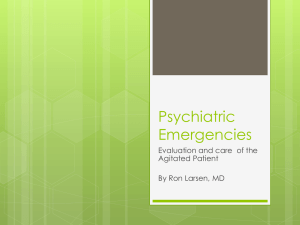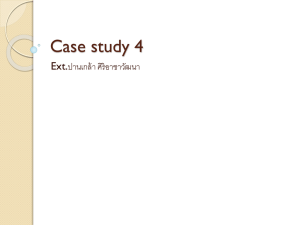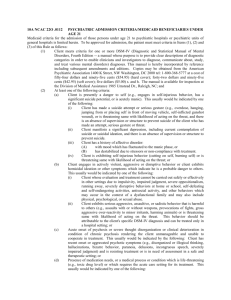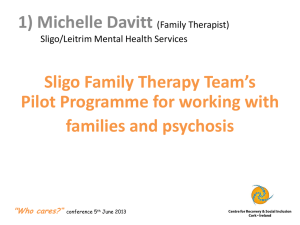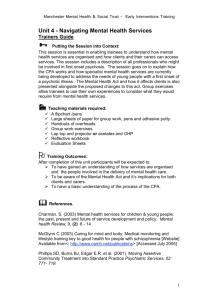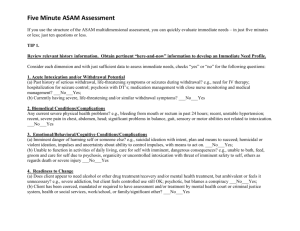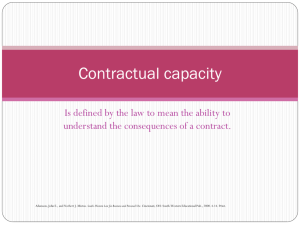Emergency Psychiatry
advertisement
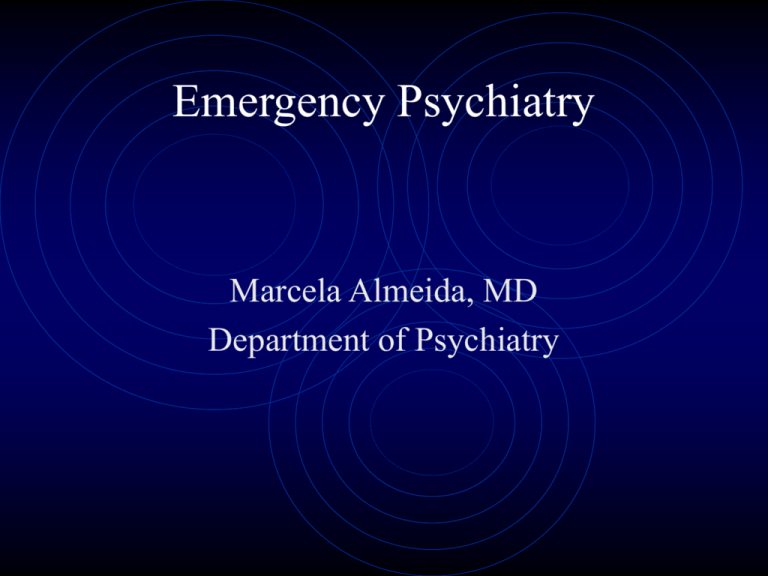
Emergency Psychiatry Marcela Almeida, MD Department of Psychiatry A Hot One You get paged by the ED resident to evaluate a patient who is apparently wreaking havoc. “He’s a hot one,” the resident says. “He’s screaming insults at every one and smashing his fists against the walls. We’re this close to pumping him with Vitamin H [haloperidol]”. “You’ll find him waiting for you in the seclusion room.” The Role of the ED Psychiatrist • First and foremost, a consultant. • An expert, presumably, in the evaluation and treatment of mental illness. • As such, the ED psychiatrist is expected to provide assistance with intractable or complex psychiatric patients. This often means spearheading interventions in the ED itself. • Often, the psychiatrist is also expected to provide input on whether a pt needs to be hospitalized or not, and whether the unwilling pt meets criteria for involuntary admission. In Preparation for the Meeting • First, one must gather information from the ED resident, as would any other consultant. • Request preliminary lab tests or other diagnostic studies. • Urine toxicology, always. Other tests are ordered depending on the particulars of the case. • Ensure that the patient is searched and gowned, and that her belongings are sequestered, if these things haven’t been already done. • Review documentation, past and present, if available. The Hot One: A Tentative Sketch 24 yo African American male with no significant past psychiatric history and a past medical history significant for asthma who is brought to the ED by paramedics contacted by the pt’s girlfriend, who arrives with the pt. She relates a two week period of escalating aggression, insomnia, agitation, bizarre behavior, and non-sensical, incoherent ideas culminating in a nearly violent altercation today in which the pt accused the girlfriend of being in league with possibly demonic forces bent on sucking out his gray matter. A Run-Through of Common Presentations • Depression • • • • • • With or without suicidality Adjustment reactions Mania Psychosis Intoxication Withdrawal A Run-Through (Cont.) • Medical issues with psychiatric manifestations, including delirium • Anxiety • Dementia • Aggression • With or without homicidality • These problems are by no means mutually exclusive; several issues may present at once. • Generally, there is one thread uniting these different presentations – the failure of outpatient or social resources to contain the problem. A Primer on Particular Problems • Suicide • Etymology. Latin origins: (sui) self- (cide) death. Ergo, • • • • self-injurious behavior sans death-wish is not a suicide attempt. Eighth leading cause of death in men. (Higher than homicide.) Third leading cause of death in adolescents (15 to 24 yo). 55% of successful suicides employ a firearm. Men succeed more often than women, but women attempt more frequently than men. • Very Difficult to Predict Developing A Sense for Suicidality • There are certain, unequivocal risk-factors • Demographic: male sex; Caucasian; social isolation; in or past middle age (most significantly > 65); occupation (past or present) that involves risk-taking; cultural or religious beliefs that favor suicide in certain situations (e.g., harikiri in Japan); local epidemics (The Sorrows of Young Werther; Kurt Cobain’s aggrieved idolators). • Historical: previous suicide attempts; history of psychiatric illness (particularly depression), impulsivity, or drug/EtOH abuse; family history of suicide; history of abuse (sexual, physical, or emotional), recent loss, or trauma; characterological vulnerabilities (particularly cluster B). Developing A Sense (Cont.) • Risk factors for suicide (cont.) • Immediate: anxiety; impulsivity; aggression; intoxication; EtOH/drug dependence; agitation; hopelessness; depression; psychosis; ideation, with plan (pt’s perception of its lethality important to clarify); physical or chronic illness; easy access to lethal methods; little access to health care; low rescue potential. • Collateral information can be very helpful at all times, but especially here – where the consequences of an incomplete story and a reticent patient can be disastrous. General Management of Suicidality • Clarify Diagnosis • Assess Risk • Active vs. Passive. Plan or no plan. Perceived lethality. • Ascertain need for inpt or outpt management • Voluntary vs. involuntary admission. Is pt at immediate risk? • If pt at elevated, albeit long-term risk, any outpatient plan should involve imminent, reliable follow up. • The more people willing to be involved in the outpatient plan the better – namely, family, friends, coworkers, physicians. “Dying is an art, like everything else. I do it exceptionally well. I do it so it feels like hell. I do it so it feels real. I guess you could say I've a call”. Sylvia Plath A Primer on Psychosis • Defined loosely as a disturbance in thought process and content, often associated with an impaired ability to relate to others and to intersubjective experience (e.g., reality). • Hallucinations, delusions, disorganized thoughts, and anomalous experiences may be evident. • The etiologies of acute psychosis include: • • • • • Affective disorders (MDD, BAD) Delirium Dementia Primary psychotic disorder Intoxication or withdrawal Developing A Hunch for Homicidality • Risk Factors: • History of violence; aggression • Impulsivity; intoxication • Sincere plan • Common etiologies include: • Psychosis (command AHs); affective disorders; personality vulnerabilities; substance intoxication or withdrawal Management of Homicidality • Elucidate Diagnosis • Clarify threat to other(s) • General vs. specific • If threat is deemed serious • Notify police • Make efforts to warn individual(s) (Tarasoff ruling) • Admit pt until threat subsides • Don’t hesitate to admit involuntarily even if precise psychiatric diagnosis remains elusive in the ED Back to the Hot One • ED evaluations should be just as comprehensive as they would be anywhere else, though the exam should be focused to address the particular question. • You find the patient banging away at the walls of his seclusion room. He is clearly agitated. • Near the door to his room, a young woman is crying – his girlfriend. You speak with her at length in order to flesh out the history. • You then proceed to enter the seclusion room. Assessing Agitation • An agitated patient shouldn’t be restrained or medicated immediately. First, the psychiatrist should determine the pt’s “risk of escalation.” • An agitated pt can be placed in one of four stages of agitation, depending on the likelihood of de-escalation. • • • • • Stage 1: the agitation is mollified by verbal cues, without limits or boundaries being invoked. Stage 2: the agitation is contained verbally through limit-setting, but it persists nonetheless. Stage 3: the agitation subsides during transient physical restraint. Stage 4: the agitation requires pharmacotherapy. It is otherwise intractable. Often stages 3 and 4 are conflated. • It takes experience to identify which pt can be safely approached, and how, and when. It is best to err on the side of caution: always have an exit strategy, and ensure that others can quickly come to your assistance, in case that’s required. • NEVER PLAY HERO(INE) AND TAKE THINGS INTO YOUR OWN HANDS! Things Heat Up You enter the pt’s room and immediately notice the wild-eyed expression, the psychomotor agitation, and the hands curled into fists. He starts to approach you, screaming, “The soul! The gray matter! The Israelis! Cannibals! Where’s your pumpkin, Uncle Sam?” He waves his arms wildly. You say, calmly, “I’m your doctor and I’m here to evaluate you.” He screams – “Gutter!” – and rushes towards you. You close the door, having identified him as a stage 3 or 4; he bangs loudly on the door, yelling “Doctor Gutter Doctor Gutter!” You obtain help. He clearly needs to be hospitalized for apparent psychosis. Furthermore, he meets criteria for involuntary admission given his aggressive, violent tendencies. Involuntary Admission • Pt at immediate risk for hurting self or others due to mental illness or mental retardation. • Pt is mentally ill (or mentally retarded) and unable to care for self as to acutely endanger his or her life. The Emergency Armamentarium • If agitated, but not psychotic: • Benzos (lorazepam) generally suffice • Beware of paradoxical disinhibition; this often occurs in the elderly • If psychotic: • Antipsychotics generally suffice • Augment with benzos for further control • If medical etiology apparent: • Use antipsychotics for behavioral control, at the same time that underlying medical illness is addressed • If substance withdrawal (sedative/EtOH): • Benzos first-line treatment • PO administration is preferred if pt amenable A Run-Down of Meds • Benzos (potentiate GABA) • Lorazepam (fast-acting): 1-2 mg PO/IM • Chlordiazepoxide (long-acting; preferred in EtOH withdrawal): 5-10 mg PO/IM • Adjust dose based on age, hepatic issues, body size, medical conditions, etc. Avoid in delirious patients, as benzos tend to exacerbate. • Antipsychotics • Typicals: Haloperidol, fluphenazine. D2 antagonism. More likely to cause EPS, TD. Older. Haloperidol: 2-10 mg PO/IM. • Atypicals: Risperidone, ziprasidone, aripiprazole, quetiapine, olanzapine. 5HT2A antagonism, D2 antagonism. Z. and A. associated with 5HT1A agonism. Less propensity for causing EPS, TD, or akathisia, but more likely to cause metabolic issues: obesity, DM. Risperidone: 1-4 mg PO. • Adjust dose based on age, body size, previous response to tx, medical issues, etc. Monitor for EPS, TD, conduction issues, metabolic problems. The Low-Down on Drugs • Intoxication • EtOH, or other sedatives (benzos) • Psychedelics, including MJ, LSD, psilocybin • Opiates • Amphetamines • Cocaine • Phencyclidine • Others: inhalants, butyl nitrate, MDMA, steroids, anti-cholinergics • Intoxication with any of these could lead to affective dysregulation and psychosis. • Pharmacotherapy generally not required for acute management, but agitation and psychosis may be treated with benzos and/or antipsychotics – especially for phencyclidine intoxication. • Elucidate extent of use, route of intake, and impairments resulting from use. The Low-Down (Cont.) • Withdrawal • Generally not medically serious, unless the pt is withdrawing from EtOH or benzos, in which case seizures may develop. Treat EtOH and benzo withdrawal with benzos. • Withdrawal from other drugs can feel terrible, no doubt about it – but not life-impairing. Cocaine withdrawal, however, is associated with intense dysphoria, sometimes AHs, and occasional active SI. • A suicidal pt withdrawing from cocaine (or other drug) may require acute psychiatric hospitalization. Other Sundry Psychiatric Emergencies • NMS (Neuroleptic Malignant Syndrome) • A medical, as well as a psychiatric emergency • Associated with anti-psychotics and with any dopamine blocking medication • Associated with muscle rigidity, autonomic dysfunction, fever, and altered mental status • Serologic markers include elevated CK, demonstrating rhabdomyolysis; metabolic acidosis; and leukocytosis • Treat by stopping offending agent, maintaining hydration, and encouraging adequate cooling. Dopamine agonists or ECT may play a role • Especially in patients with longstanding psychosis, NMS may be confused with catatonia, which is not associated with autonomic dysfunction nor fever. This can be a fatal oversight, so always keep NMS in mind Other Emergencies (Cont.) • Lithium Toxicity • Associated with nausea, vomiting, diarrhea, weakness, fatigue, lethargy, confusion, seizure, and potentially coma • Toxicity not entirely correlated with serum lithium level; toxicity may develop at different levels for different people • Obtain BMP, serum lithium level, and EKG • Encourage hydration; consider hemodialysis in extreme cases

